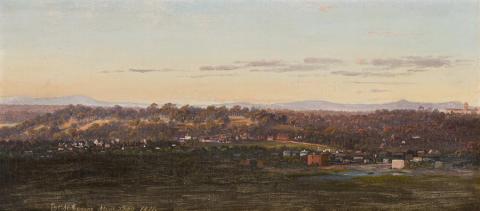DISTANT VIEW TOWARDS YARRA BEND FROM OUR LITTLE TOWER, 1871
EUGENE VON GUERARD
oil on canvas on board
15.5 x 33.5 cm
dated and inscribed lower left: East Melbourne March 25-27 1871.
inscribed verso: Fernsicht nach Yarra Bend / von unserem Thürmchen
bears inscription verso: EUGEN von GUERARD - (view from our little tower) 1871 / From his house (now ours) built in GIPPS ST East Melbourne in 1861 / Maie Casey / Eugene von Guerard 1871
The Estate of The Lady Casey, Melbourne
Eugene von Guérard: Nature Revealed, National Gallery of Victoria, Melbourne, 16 April – 7 August 2011
Bruce, C., Comstock, E. and McDonald, F., Eugene von Guérard, 1811–1901: a German Romantic in the Antipodes, Alister Taylor, Martinborough, 1982, pp. 232–233, 254, cat. 133 (illus.)
Pullin, R., Eugene von Guérard: NatureRevealed, National Gallery of Victoria, Melbourne, 2011, pp. 232–233, 295 (illus.)
In the midst of grand, panoramic views celebrating the sublime in nature with all the detailed splendour that Eugene von Guerard could command, Distant view towards Yarra Bend from our Little Tower, 1871 comes as a pleasing diversion, intimate in the informal glimpse it gives us of the artist. Painted from the little tower, (or 'Thurmchen' as he affectionately called it), of his home in East Melbourne, von Guerard inscribed into the paint the date of the three evenings he painted it in March. Ruth Pullin, in her scholarly publication on the artist, suggested that 'in order to capture the rapidly changing light and colour effects at a particular hour of the day, von Guerard painted this view at the same time over three successive evenings.'1 Although quickly painted, von Guerard was not an Impressionist, so the transient effects had to be recorded successively rather than in one direct response. While the broad, panoramic sweep is typical, its size is more intimate when compared with other such paintings as Schnapper Point from Beleura, 1870 (Art Gallery of Western Australia, Perth). Moreover, it continues the romantic theme that runs throughout von Guerard's work in his expression of wonderment before nature, a wonderment so strong that it often took on a reverential mood.
Distant view towards Yarra Bend from our Little Tower 1871 was painted during an important time in von Guerard's life in Melbourne. In 1870he had been appointed Master of the Painting School and Curator of the National Gallery of Victoria, in effect the Gallery's first director. Along with Louis Buvelot, he was a foundation council member of the Victorian Academy of Arts, exhibiting in its inaugural exhibition of 1870 such masterpieces as Dandenong Ranges from Beleura, 1870 (National Gallery of Australia, Canberra). Furthermore, the National Gallery of Victoria acquired Mount Kosciusko, 1866, its second work by the master. And to crown the year, he was a warded the Cross of the Order of Franz Josef. In addition to its aesthetic appeal, Distant view towards Yarra Bend from our Little Tower, 1871 provides a fascinating historical record of how Melbourne looked in those times. While Pullin has suggested the identification of the building on the horizon's far right as the Kew Lunatic Asylum of 1864-72, the painting's fascination lies very much in the encroachment of domestic buildings into the natural scenery. Von Guerard had moved to the village of East Melbourne in 1862. His home was at 12 (now 159) Gipps Street. When this painting was in the collection of Lord and Lady Casey, it hung once again in the same house.
1. Pullin, R., Eugene von Guerard: Nature Revealed, National Gallery of Victoria, Melbourne, 2011, p. 232
DAVID THOMAS
